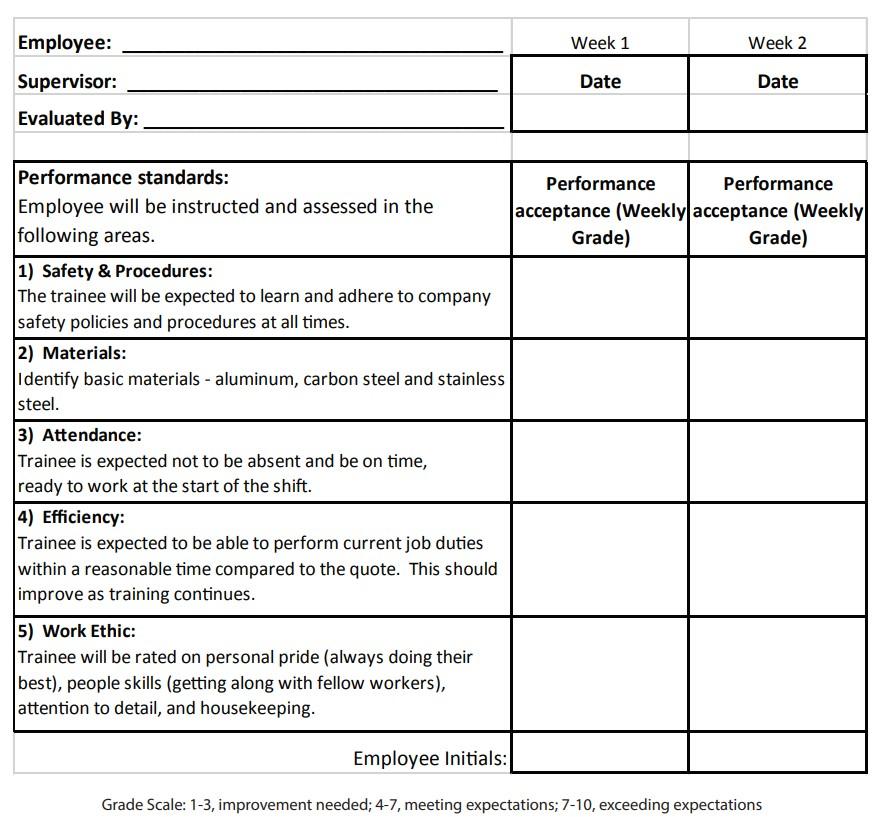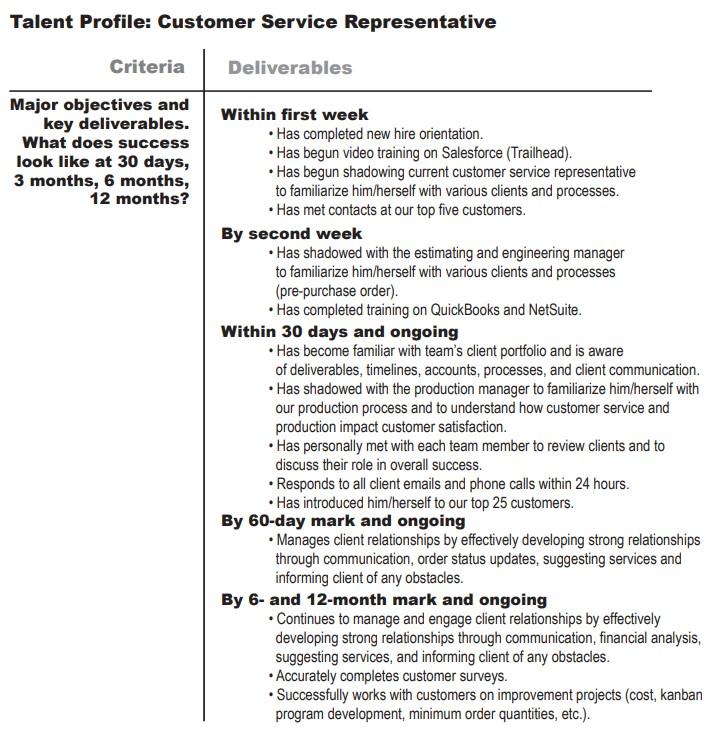- FMA
- The Fabricator
- FABTECH
- Canadian Metalworking
Categories
- Additive Manufacturing
- Aluminum Welding
- Arc Welding
- Assembly and Joining
- Automation and Robotics
- Bending and Forming
- Consumables
- Cutting and Weld Prep
- Electric Vehicles
- En Español
- Finishing
- Hydroforming
- Laser Cutting
- Laser Welding
- Machining
- Manufacturing Software
- Materials Handling
- Metals/Materials
- Oxyfuel Cutting
- Plasma Cutting
- Power Tools
- Punching and Other Holemaking
- Roll Forming
- Safety
- Sawing
- Shearing
- Shop Management
- Testing and Measuring
- Tube and Pipe Fabrication
- Tube and Pipe Production
- Waterjet Cutting
Industry Directory
Webcasts
Podcasts
FAB 40
Advertise
Subscribe
Account Login
Search
How manufacturing facility managers can perfect the performance appraisal
Why it's important to provide feedback during the first 90 days for metal fabrication businesses
- By Mark Ernst
- August 24, 2021
- Article
- Shop Management

Many managers at metal fabrication and other manufacturing shops share the same mindset about performance reviews: “I just don’t have the time.” In an era of perennial skilled labor shortages, thinking this way is a costly mistake. Getty Images
Evaluating performance, especially of new employees, is a challenge for most businesses, particularly small ones. Why? Because everyone is busy doing their “day job,” and owners don’t have the time to explain to new employees the details of the job, especially when hiring experienced people. “They should know what the job is,” you might think, “and I shouldn’t have to tell them.”
The flaw in that thinking is that you miss opportunities to guide your new employee to full productivity faster by learning how your shop does things, recognizing those things being done well, and correcting deficiencies before they become bad habits.
It’s as if you’re sending a rocket ship to Mars. On Earth your team does the most precise trajectory calculations possible for the 134.9-million-mile trip. Unfortunately, the calculation is off by 0.1 degree. If no further trajectory calculations are made, can you guess how many miles you miss Mars by? I am sure we can agree by a bunch, and you would see Mars out the window as you pass by.
An employee’s performance is much like the trajectory calculations for the Mars trip. If you give the new hire even the most detailed instructions about the job, what you expect, and other details about working at your manufacturing company on the first day, but then give no further instruction or feedback along the way, can you guess how well employees will be performing after 90 days compared to your initial expectations? Assuming employees don’t quit because they feel frustrated, lost, or ignored, they probably will be missing some key performance and behavioral expectations.
You probably know that having some (easy) method to evaluate performance and give feedback would be worthwhile, but you also might feel the same way many metal fabrication shop managers do: I just don’t have time to do it.
Years ago I learned a simple formula for success from venture capitalist Enzo Torresi: Expectations - Reality = Happiness. If the “expectations” factor is a positive number (that is, you have positive expectations), the math works. Think about this in your life and work experience. If your expectations are met or exceeded, you are happy. If they are not met or fall short, you are not happy.
Do your new hires know what your expectations are for them, including the quantity, quality, and timing of results? Do they know what co-workers expect from them and what they can expect from their co-workers? Most important, do your new hires know what your customers’ expectations are in terms of product quality, delivery, and communication? Your customers don’t care why their expectations are not met. All they know is it is your job as a business owner to make it happen. Therefore, making sure all employees know what those expectations are, especially new hires, helps ensure those expectations can be met.
So, where do you begin? Try starting with a four-step process that involves implementing a performance management program and identifying challenges. It starts the same way any improvement project does, by assessing what you already have.
1. Assess Your Current System
Assess your current system or program by asking yourself the following questions:
- Do I have a current method of reviewing performance? If so, does it work? What parts don’t work and why?
- Do our managers and employees understand it? Does it guide new hires to more productivity?
- Is it effective at recognizing high performers and driving higher performance?
- Is it effective at weeding out poor performers? Does it provide effective documentation?
- Does it provide an effective, objective way to determine merit pay increases?
Think about your culture and your managers’ current level of sophistication to conduct performance reviews. Even more important for new hires, can your managers set initial expectations and give effective feedback?

FIGURE 1. This rating sheet spells out exactly what’s expected for a new CNC operator and by when. The complete chart extends out to the right, giving room for eight weeks of feedback. Chart courtesy of Cameron Manufacturing & Design, Horseheads, N.Y.; Matthew Sharpe, CEO/president.
Does your organization embrace a culture of giving and receiving feedback? Or is it one that tends to focus on giving constructive feedback only when someone is not meeting performance or behavioral expectations? Or does feedback come only just prior to a termination decision? If this is the case, work with a consultant who can help you change this aspect of your culture.
Regular feedback for all employees is crucial to maintaining an effective and motivated workforce. For new hires, regular feedback is even more important. It shows you care about them and you want them to succeed, and it helps them achieve productivity goals quickly.
2. Implement a Performance Management Program
This is especially important for new hires during those first critical 90 days. The goal of a performance management program for new hires is to ensure their successful ramp-up to full productivity.
For all employees, when you consistently evaluate them, you raise their overall performance. Consistent evaluations allow for more opportunities to recognize and appreciate good performance. They also give opportunities to correct poor performance and behavior before bad habits settle in. If you don’t evaluate performance consistently, before long you might terminate that new employee or, just as bad, lose good employees who become frustrated by a new employee’s poor performance. The goal is to move away from a subjective system that is not driving the correct performance and behaviors.
Keep in mind we are in the midst of a growing labor crisis. There are an insufficient number of qualified employees for the many roles open. If you neither set clear expectations nor coach or develop your new hires, you could be losing potentially good employees just because you didn’t take the time to make sure they understood the job and were coached how to do it.
3. Identify Challenges in Implementing the Program
First, you need management commitment from the top down. Without this, any performance management program will fail. The owner or very senior operating executive must be the sponsor or champion of the program. This cannot be a project owned by the HR manager or other staff executive. It has to be someone with authority to make decisions and hold people accountable.
Define clear and measurable performance expectations and results for each position. Do this by thinking about the results the new hire must deliver daily, weekly, monthly, quarterly, and annually, as well as the competencies needed to achieve those results.
Fab shop managers must be trained to assess performance and deliver clear and effective feedback. For many, this is a new skill that they will have to be taught.
Such education is critical. Managers are key to any successful performance management program. They are the most influential force on the shop floor. Why are some employees engaged and others aren’t, even though they all work for the same manufacturing company? More than likely, engaged employees have better managers. In fact, Gallup Inc. found that a manager’s effectiveness can account for up to 70% of the variance in employee engagement scores across business units within the same company or different companies.
4. Develop Workable Policies and Procedures
Regardless of how formal your performance program is, it needs workable policies and procedures. The policy must define what must be done, who must do it, and when. Also, who must review and approve the performance review before it is given to the employee?
I strongly recommend you do not rely on generic, ready-made performance review forms, especially for new hires. These forms might ask, Is the employee’s work complete and accurate? Does the employee consistently complete work and meet deadlines? Does the employee identify problems and make sound or logical decisions?

FIGURE 2. This template outlines how a review form can spell out specific performance objectives and expected results. It also leaves room for feedback after a person’s first 30, 60, and 90 days on the job.
The generic questions go on. What do these catch-all forms communicate to employees? How do they relate to their jobs and the results they are paid to achieve at your shop? These generic forms lend themselves to subjective reviews that don’t communicate effective feedback to the employee. During the first 90 days, you need to tell new hires what they are doing well, what they must improve on, and how.
Figure 1 shows a sample of a new-hire form for a CNC operator at Cameron Manufacturing & Design, Horseheads, N.Y. Notice how it spells out expectations, including the time frame to learn new skills. Also notice the grade scale at the bottom of the form. If managers use this in conjunction with effective positive and constructive feedback, new hires will know what they are doing well, what they need to improve, and how they are fitting into the company as a productive employee.
Still, the form itself can’t answer every question or eliminate all ambiguity. For instance, shop floor managers need to define what terms such as work ethic, housekeeping, and people skills mean, using company-specific examples so that new hires really know what is expected of them.
Figure 2 shows a simple template for a job-specific performance review for an employee’s first 90 days on the job. Each objective should outline specific expectations and exactly what must be completed by when. The form gives space for feedback after 30, 60, and 90 days, and this feedback should spur meaningful discussions between new hires and their managers.
I like to add weight for each objective. Is this objective 50% of the job or just 10%? With this knowledge, new hires know how much time and effort to give each expectation. This is another area for the manager to have a meaningful discussion with the new hire.
Figure 3, which comes from Wyoming Machine in Stacy, Minn., does a good job of outlining what deliverables are due in each of the first weeks of employment all the way up to the six- and 12-month mark. Notice the specificity of the deliverables. These allow the manager to provide specific feedback and the new hire to know how they are doing.
The importance of providing new hires with specific job expectations that cover all aspects of their job—not just the technical parts or productivity goals—cannot be overstated. New hires should be given information about the company culture and the performance and behavioral expectations for employees. This goes beyond the hours of work, lunch break, and holidays.
Expectations should include qualitative information such as quality standards; reporting errors; doing the job the right way; treatment of customers; and other aspects such as how employees treat each other, mutual respect, and teamwork.
It is also important to tie job expectations to company goals, customer expectations, and safety. This helps new hires understand “the why” behind each job expectation, lest performance reviews be seen as busy work or fluff. Too often manufacturing companies fail to explain “the why” to employees, which then breeds contempt for the expectation. The new hire must see how each expectation—whether quantitative (making X number of units per hour) or qualitative (maintaining good housekeeping in the work area)—ties into an important company goal.
New hires who understand exactly what is expected of them and receive timely and frank feedback can be expected to ramp up to full productivity quickly and become a contributing member of the company team. Overall, performance reviews are all about making employees happy, productive, and feel valued and appreciated for their contributions. In these days of never-ending labor challenges and shortages, nothing could be more important.
About the Author
Mark Ernst
PO Box 1075 , CA
Artesia, CA 90702
714-329-2228
subscribe now

The Fabricator is North America's leading magazine for the metal forming and fabricating industry. The magazine delivers the news, technical articles, and case histories that enable fabricators to do their jobs more efficiently. The Fabricator has served the industry since 1970.
start your free subscription- Stay connected from anywhere

Easily access valuable industry resources now with full access to the digital edition of The Fabricator.

Easily access valuable industry resources now with full access to the digital edition of The Welder.

Easily access valuable industry resources now with full access to the digital edition of The Tube and Pipe Journal.
- Podcasting
- Podcast:
- The Fabricator Podcast
- Published:
- 04/30/2024
- Running Time:
- 53:00
Seth Feldman of Iowa-based Wertzbaugher Services joins The Fabricator Podcast to offer his take as a Gen Zer...
- Industry Events
Pipe and Tube Conference
- May 21 - 22, 2024
- Omaha, NE
World-Class Roll Forming Workshop
- June 5 - 6, 2024
- Louisville, KY
Advanced Laser Application Workshop
- June 25 - 27, 2024
- Novi, MI
Precision Press Brake Certificate Course
- July 31 - August 1, 2024
- Elgin,
































